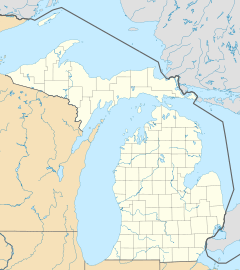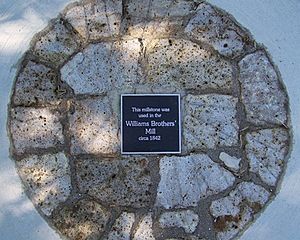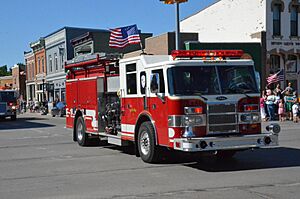Williamston, Michigan facts for kids
Quick facts for kids
Williamston, Michigan
|
||
|---|---|---|
| City of Williamston | ||
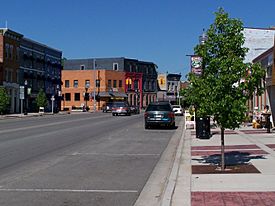
Downtown looking east along Grand River Avenue
|
||
|
||
| Motto(s):
Discover the Charm
|
||
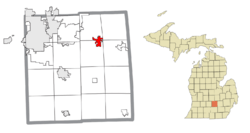
Location within Ingham County
|
||
| Country | United States | |
| State | Michigan | |
| County | Ingham | |
| Settled | 1834 | |
| Incorporated | 1871 (village) 1945 (city) |
|
| Government | ||
| • Type | Mayor–council | |
| Area | ||
| • Total | 2.52 sq mi (6.54 km2) | |
| • Land | 2.45 sq mi (6.35 km2) | |
| • Water | 0.07 sq mi (0.18 km2) | |
| Elevation | 892 ft (272 m) | |
| Population
(2020)
|
||
| • Total | 3,819 | |
| • Density | 1,556.87/sq mi (600.99/km2) | |
| Time zone | UTC-5 (EST) | |
| • Summer (DST) | UTC-4 (EDT) | |
| ZIP code(s) |
48895
|
|
| Area code(s) | 517 | |
| FIPS code | 26-87420 | |
| GNIS feature ID | 1627274 | |
Williamston is a city located in Ingham County, in the state of Michigan, USA. In 2010, about 3,854 people lived there. Williamston is east of Lansing, Michigan's capital city. It shares borders with Williamstown Township to the north and Wheatfield Township to the south. The Red Cedar River and M-43 highway both run through the middle of the city.
Contents
A Look at Williamston's Past
Williamston began as a meeting point for two important Native American trails. These were the Grand River and Saginaw Indian Trails. A small group of the Saginaw tribe, part of the Chippewa People, used this area. They visited Williamston as a 'summer village' to plant crops and hold gatherings. They mostly used the land north of the Red Cedar River.
European settlers arrived in 1834. Hiram and Joseph Putnam moved here from Jackson. They stayed for less than a year, but they planted and harvested a crop of oats. Today, a street inside the city is named Putnam Street in their honor.
In 1839, the Putnam brothers sold their land to three brothers from Batavia, New York. Their names were Oswald B., James M., and Horace B. Williams. James M. "Miles" Williams was important to the town's growth. He built a dam, a sawmill, and later a grist mill (a mill for grinding grain). In 1845, he officially mapped out the land and named the town "Williamstown" after himself. Over time, the "w" was dropped, and it became "Williamston."
In the 1800s, Williamston was a popular stop on the Grand River trail. This trail later became a plank road (a road made of wooden planks). It connected Detroit to Lansing. Since traveling by horse and buggy took more than a day, Williamston was a good place to stop overnight. This trail is now Grand River Avenue (M-43), which goes through downtown Williamston.
Williamston officially became a village in 1871. It then became a city on April 1, 1945. The city's rules, called the City Charter, were updated in 1963 and are still used today. Many books have been written about Williamston's history, including one for its 100-year celebration in 1971.
Where is Williamston?
Williamston is about 15 miles east of Lansing, which is Michigan's capital city. It's also 11 miles east of East Lansing, where Michigan State University is located. The city is just two miles north of I-96. This major highway helps people travel to Lansing and Detroit.
The city covers about 2.52 square miles (6.54 square kilometers). Most of this area is land, with a small part being water.
The Red Cedar River flows just north of the city center. This river eventually flows into the Grand River. Lake Lansing is also nearby in Haslett. It is a large lake, covering about 500 acres.
Williamston's Weather
Williamston has a type of weather called a humid continental climate. This means it has big changes in temperature throughout the year. Summers are warm to hot and often humid. Winters are cold, and sometimes very cold.
People of Williamston
| Historical population | |||
|---|---|---|---|
| Census | Pop. | %± | |
| 1880 | 982 | — | |
| 1890 | 1,139 | 16.0% | |
| 1900 | 1,113 | −2.3% | |
| 1910 | 1,042 | −6.4% | |
| 1920 | 1,060 | 1.7% | |
| 1930 | 1,458 | 37.5% | |
| 1940 | 1,704 | 16.9% | |
| 1950 | 2,051 | 20.4% | |
| 1960 | 2,214 | 7.9% | |
| 1970 | 2,600 | 17.4% | |
| 1980 | 2,981 | 14.7% | |
| 1990 | 2,922 | −2.0% | |
| 2000 | 3,441 | 17.8% | |
| 2010 | 3,854 | 12.0% | |
| 2020 | 3,819 | −0.9% | |
| U.S. Decennial Census | |||
In 2010, there were 3,854 people living in Williamston. There were 1,605 households, which are groups of people living together. About 1,002 of these were families. The city had about 1,579 people per square mile.
Most of the people living in Williamston were White (94.4%). There were also smaller groups of African American, Native American, and Asian residents. About 3.1% of the population was Hispanic or Latino.
In many households, 35.8% had children under 18 living with them. The average household had 2.40 people. The average family had 3.05 people. The median age in the city was 35.9 years old. This means half the people were younger than 35.9 and half were older.
Williamston's Economy
Today, Williamston is mostly a "bedroom community." This means many people who live there travel to bigger towns for work. They might go to places like Okemos, East Lansing, or Lansing. These larger towns offer more job opportunities. In the past, farming was very important to Williamston. While there isn't much farmland in the city now, the areas around it are still used for farming.
Williamston is known in mid-Michigan for its antique stores and unique shops downtown. The city has two golf courses: The Brookshire Restaurant and Golf Course, and Wheatfield Valley Golf Course. You can also find the Williamston Theatre, which offers live plays. The Sun Theatre is an old-style movie theater with one screen.
The city also has a branch of the Capital Area District Library. There are many restaurants, a market, and a grocery store. You can also find clothing stores, small shops, and more antique dealers. The Meridian Mall is in nearby Okemos. The largest employer in Williamston is the Williamston Community Schools, which has about 170 employees.
Habitat for Humanity has a special store and training center here. An industrial park has also opened near I-96. This highway is a main route between Grand Rapids, Lansing, and Detroit.
Fun Things to Do in Williamston
Williamston hosts several fun events throughout the year!
- Red Cedar Jubilee: This is a week-long festival that usually starts in the last week of June. It kicks off with a children's bike parade. Events include a demolition derby, a duck race, and a chicken barbecue. There are also many games and activities for kids of all ages. Money raised from some events helps local community groups.
- Artfest on the River: This festival used to happen in July at McCormick Park. It features vendors, free activities for children, and live music. After a break, it returned in 2013.
- Dog Days of Summer: In early August, this event encourages dog owners to bring their pets. Activities include a pet parade, an ugly dog contest, and agility shows. The Ingham County Animal Shelter also holds a pet adoption and fundraising event.
- Labor Day Bridge Walk: The city used to sponsor a walk on Labor Day. The former Mayor would lead a walk through town, pointing out historical places. It included crossing the Red Cedar River. This walk was a chance to learn about Williamston's history and enjoy the holiday.
- Light Parade: On the first Saturday in December, downtown Williamston hosts a Light Parade. Activities start in the afternoon. The main event is a parade of lighted floats and vehicles. Afterward, children can meet Santa Claus. Stores sell hot drinks, and musicians play in the streets. Sometimes, you can even see ice sculptures.
- Farmers' Market: In the Spring, Summer, and Fall, Williamston has a weekly Farmers' Market downtown. You can find fresh local produce and other goods there.
Schools in Williamston
The public schools in Williamston are part of Williamston Community Schools.
- Younger students (Kindergarten to 2nd grade) go to Discovery Elementary.
- Older elementary students (3rd to 5th grade) go to Explorer Elementary.
- Middle school students (6th to 8th grade) attend Williamston Middle School.
- High school students (9th to 12th grade) go to Williamston High School.
There are also private schools in the area. St. Mary School is in Williamston. Memorial Lutheran is in nearby Williamstown Township.
See also
 In Spanish: Williamston (Míchigan) para niños
In Spanish: Williamston (Míchigan) para niños



